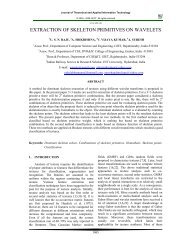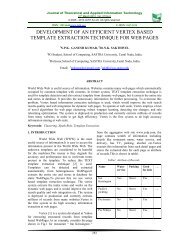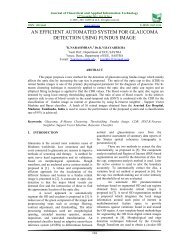Full Text - Journal of Theoretical and Applied Information Technology
Full Text - Journal of Theoretical and Applied Information Technology
Full Text - Journal of Theoretical and Applied Information Technology
You also want an ePaper? Increase the reach of your titles
YUMPU automatically turns print PDFs into web optimized ePapers that Google loves.
<strong>Journal</strong> <strong>of</strong> <strong>Theoretical</strong> <strong>and</strong> <strong>Applied</strong> <strong>Information</strong> <strong>Technology</strong><br />
10 th June 2013. Vol. 52 No.1<br />
© 2005 - 2013 JATIT & LLS. All rights reserved .<br />
ISSN: 1992-8645 www.jatit.org E-ISSN: 1817-3195<br />
(11)<br />
C<br />
m n<br />
i<br />
throughput<br />
pS p<br />
i j<br />
i= 1 j=<br />
1 n<br />
= ∑∑ ù<br />
In which, the probability, which the source (or<br />
relay) node sent information was p .<br />
5. THROUGHPUT ANALYSIS<br />
Now we analyse the throughput <strong>of</strong> multi-source<br />
sink relay sensor network.<br />
Throughput <strong>of</strong> sensor network when m= n = 1<br />
There is only a source (or relay) node S 1<br />
<strong>and</strong> a<br />
target (or relay) node R<br />
1<br />
, i = j = 1 , so it is a<br />
situation <strong>of</strong> unicast <strong>and</strong> non-cooperation diversity.<br />
Because the probability density function <strong>of</strong> gain<br />
2<br />
| g<br />
ij<br />
| is p 2 ( x ) = e − x , <strong>and</strong> in here i = j = 1 , so<br />
| g |<br />
ij<br />
from the formula (9) <strong>and</strong> (11), we have:<br />
C = ù = =<br />
p Pr{ t < 1}<br />
throughput, m n 1 1 S1<br />
1<br />
⎧ ù<br />
⎫<br />
1<br />
= ù<br />
1<br />
p S<br />
Pr ⎨<br />
< 1<br />
1<br />
2 ⎬<br />
⎩log(1 + | g11 | ⋅PS<br />
(<br />
1))<br />
⎭<br />
ù 1<br />
⎧e<br />
−1<br />
2<br />
⎫<br />
+∞<br />
− x<br />
= ù<br />
1<br />
pS<br />
Pr ⎨ < | g<br />
1<br />
11<br />
| ⎬ = 1<br />
1<br />
1<br />
1<br />
⎩PS<br />
(<br />
1)<br />
ù pS<br />
∫ e e dx<br />
ù −<br />
⎭<br />
P( S1<br />
)<br />
ù 1<br />
⎧ e −1⎫<br />
= ù<br />
1<br />
pS<br />
exp ⎨−<br />
⎬<br />
(12)<br />
1<br />
⎩ PS (<br />
1)<br />
⎭<br />
From(12), if the source (or relay ) node S 1<br />
sent the information to R<br />
1<br />
with the nonzero<br />
probability p<br />
S 1<br />
<strong>and</strong> the rate ù 1<br />
, C<br />
throughput, m= n=<br />
1<br />
reached the maximum. Hence, when the level <strong>of</strong><br />
node power <strong>and</strong> the possibility <strong>of</strong> sending<br />
information are to achieve a dynamic balance, the<br />
throughput was maximum.<br />
Throughput <strong>of</strong> sensor network when m = 2 ,<br />
n = 2<br />
There were two source (or relay) nodes <strong>and</strong><br />
target (or relay) nodes, respectively, <strong>and</strong> the<br />
network was based on the cooperative diversity<br />
model, radio strategy <strong>and</strong> decoding technology<br />
mentioned above in this paper. Because the Joint<br />
2<br />
probability density function16 <strong>of</strong> gain | g<br />
i1<br />
| <strong>and</strong><br />
2<br />
| g | ( i = 1, 2) was<br />
i2<br />
S i<br />
<strong>and</strong> the conditional probability density function was<br />
y x<br />
p ( x| y)<br />
= e − , ( i = 1, 2) . We have the<br />
2 2<br />
| gi1| | gi2|<br />
theorem 1.<br />
Theorem 1 Based on the cooperative diversity<br />
model, radio strategy <strong>and</strong> decoding technology<br />
mentioned above, the parameters were described as<br />
2<br />
following: the path index was | g<br />
ij<br />
| , the<br />
2<br />
cooperation index was G , the power <strong>of</strong> source<br />
node was PS ( i<br />
) , the rate <strong>of</strong> sending information<br />
was ù<br />
i<br />
, i, j = 1, 2 . Then the throughput <strong>of</strong> sensor<br />
network was:<br />
2<br />
i S<br />
C<br />
throughput, m= n= 2<br />
= ∑<br />
i<br />
(<br />
i=<br />
1 2<br />
ù<br />
p<br />
L<br />
× 1+ e − e − L<br />
+<br />
ù 1 ù 2<br />
⎧ ⎫ ⎧ ⎫⎞<br />
e −1 e −1<br />
+ exp ⎨− ⎬+ exp ⎨− ⎬ PS ( ) PS ( ) ⎟<br />
In which<br />
⎩ 1 ⎭ ⎩ 2 ⎭⎠<br />
{ ù L G g ù − }<br />
exp<br />
i<br />
( ,<br />
i2, ) 1<br />
L =<br />
,<strong>and</strong><br />
PS ( )<br />
L( G, g , )<br />
i<br />
2 2<br />
( g<br />
2<br />
PS G )<br />
log 1 + | | ( ) + −ù<br />
i i i<br />
i2 ù =<br />
2 2<br />
⎛1 + | gi2<br />
| PS (<br />
i)<br />
+ G ⎞<br />
log ⎜<br />
2 ⎟<br />
1 + | gi2<br />
| PS (<br />
i)<br />
The pro<strong>of</strong> <strong>of</strong> thoerem 1 see appendix.<br />
⎝<br />
⎠<br />
(13)<br />
Obviously, it included the throughput under the<br />
condition <strong>of</strong> non-cooperation relay in the formula<br />
(23), this emphasizes the fact that the throughput<br />
could be improved by cooperative diversity. For the<br />
common m <strong>and</strong> n , similar to the mark mentioned<br />
above, we have<br />
L( G, gi2, g<br />
i3, ù ) ,…, L( G, gi2, gi3,..., g<br />
ij<br />
, , ù )<br />
<strong>and</strong> L1,..., L<br />
j−2<br />
,thereby, we have the following<br />
corollary.<br />
Corollary: For the other m <strong>and</strong> n , Under the<br />
condition <strong>of</strong> theorem 1, the calculation formula <strong>of</strong><br />
throughput <strong>of</strong> multi-hop relay sensor network based<br />
on cooperative diversity technology was<br />
C<br />
throughput<br />
=<br />
⎛ ⎧ 1⎫⎪<br />
⎜ + − + − ⎬+<br />
⎝<br />
⎪⎩<br />
( ) ⎪⎭<br />
m<br />
n<br />
ù j<br />
ù<br />
i<br />
L −L<br />
⎪ e −<br />
∑ pS<br />
1 e e exp ⎨<br />
i<br />
i= 1 n ⎜ ∑<br />
j=<br />
1 PSj<br />
−x<br />
p| | , | |( xy , ) = e e<br />
2 2<br />
gi1 gi2<br />
−y<br />
, ( i = 1, 2) ,<br />
7
















